
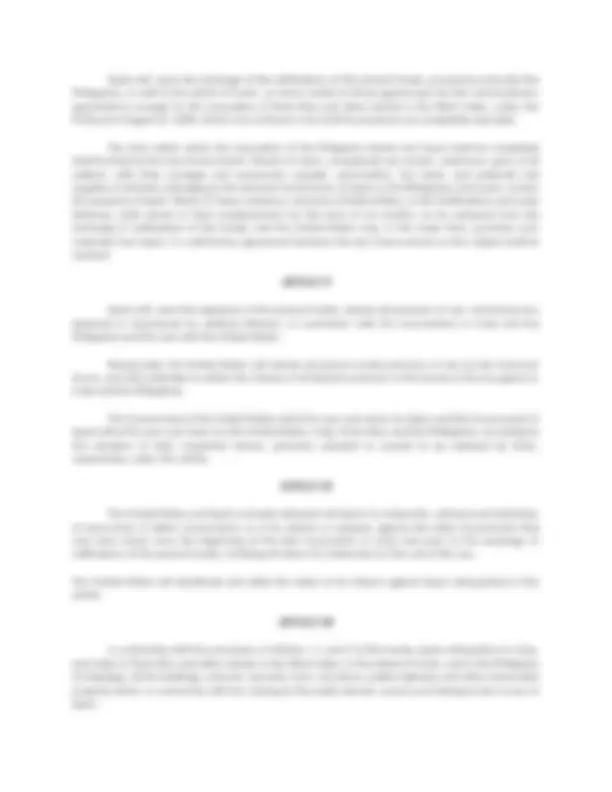
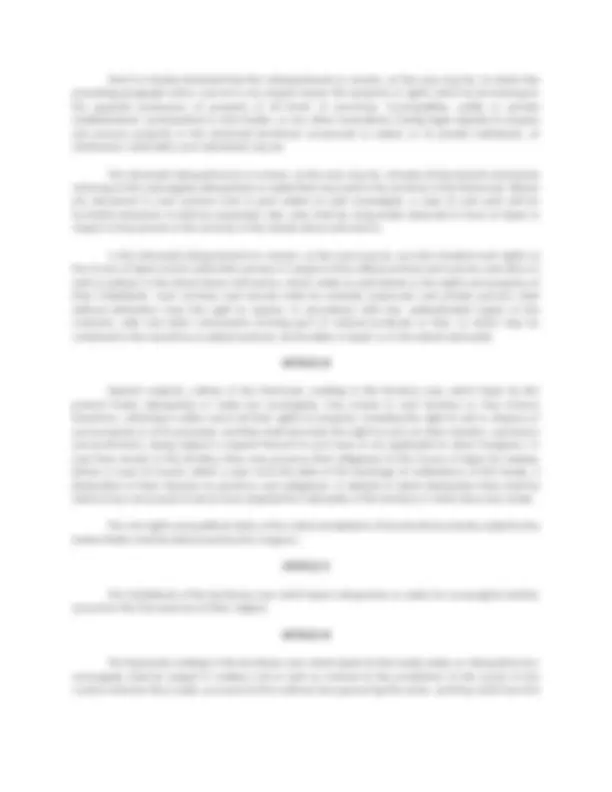
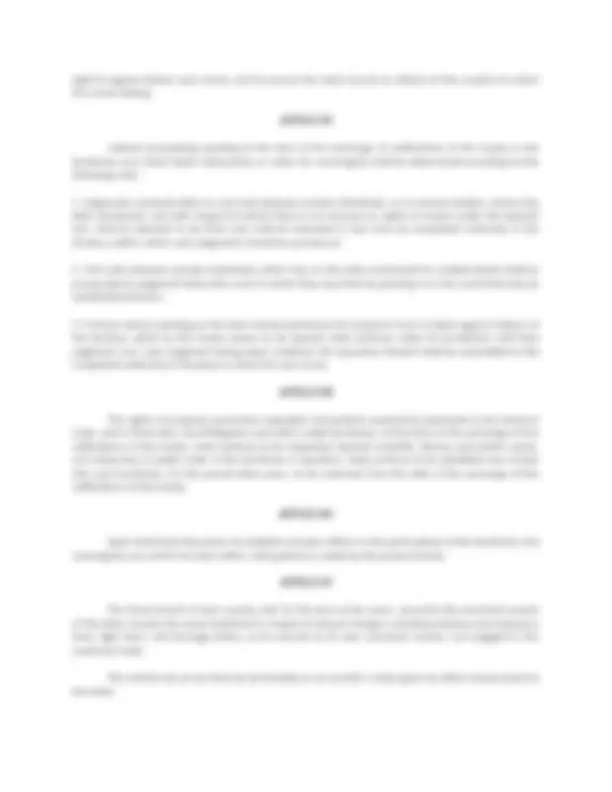
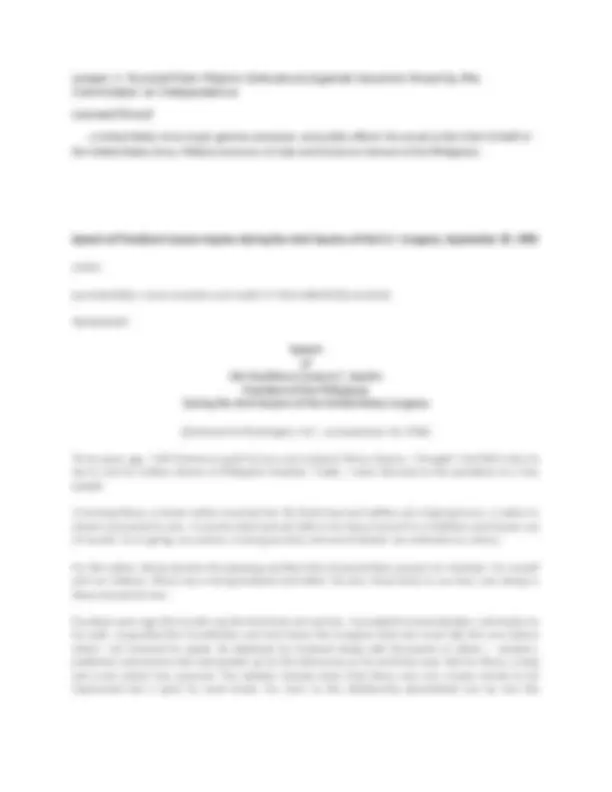
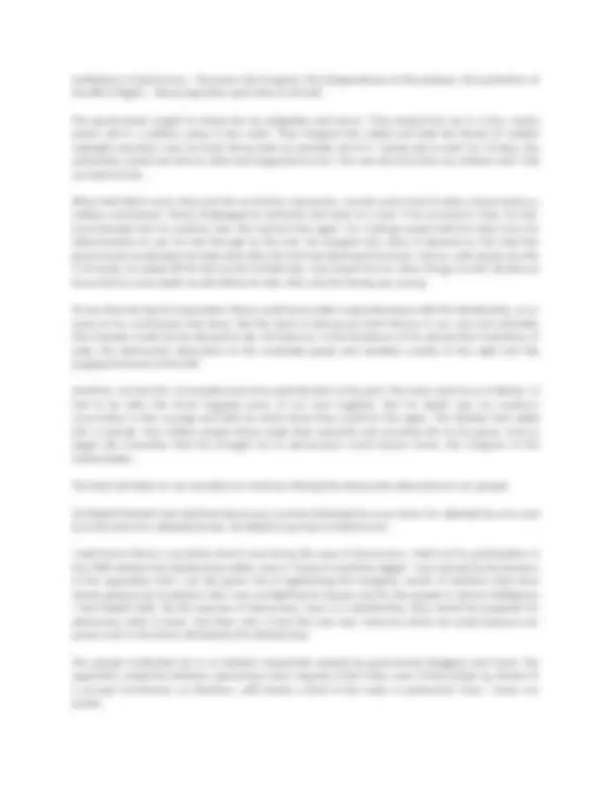
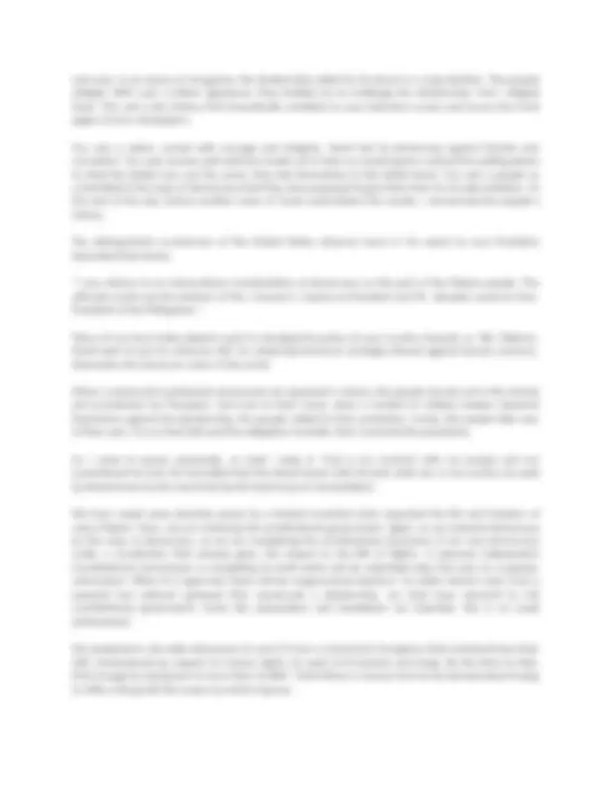

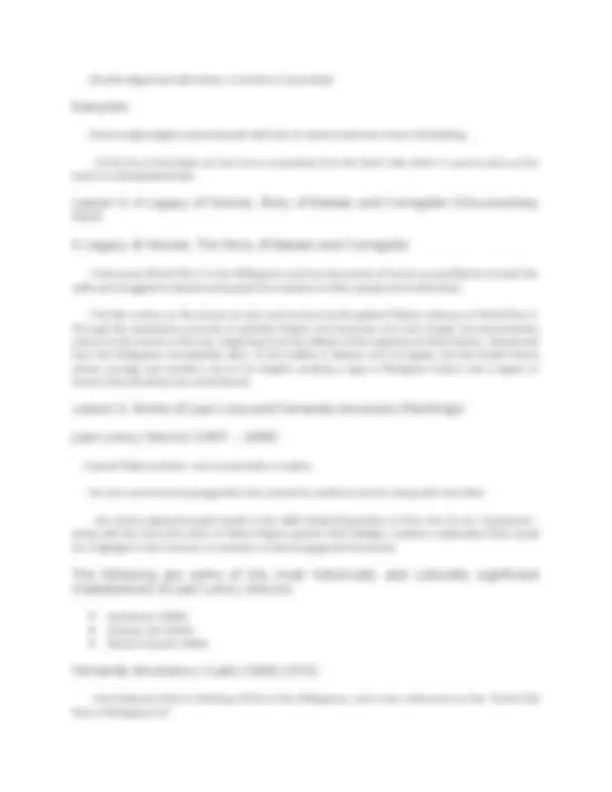
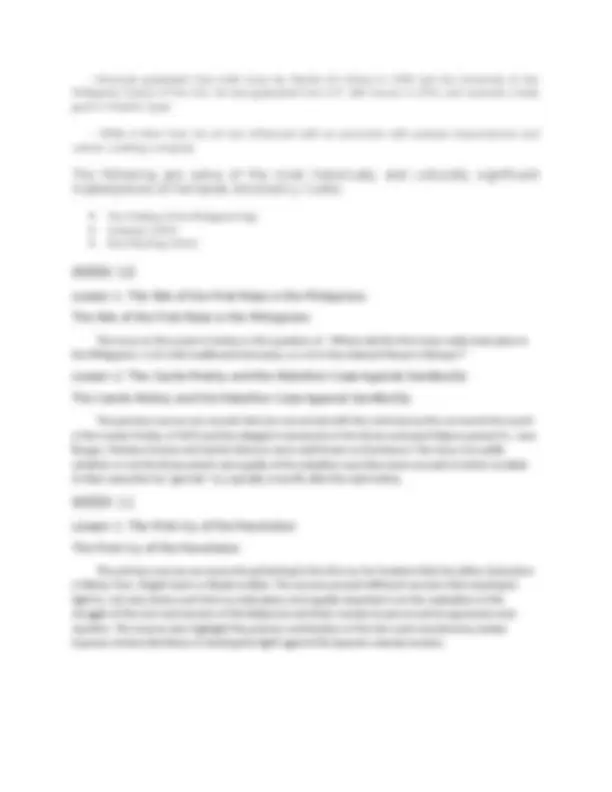


Study with the several resources on Docsity

Earn points by helping other students or get them with a premium plan


Prepare for your exams
Study with the several resources on Docsity

Earn points to download
Earn points by helping other students or get them with a premium plan
Community
Ask the community for help and clear up your study doubts
Discover the best universities in your country according to Docsity users
Free resources
Download our free guides on studying techniques, anxiety management strategies, and thesis advice from Docsity tutors
it talks about the history and its relevance to the Philippine History and it includes a reviewer
Typology: Essays (university)
1 / 15

This page cannot be seen from the preview
Don't miss anything!










December 10, 1898 Treaty of Peace Between the United States of America and the Kingdom of Spain (Treaty of Paris) By the President of the United States of America* [ Signed in Paris, December 10, 1898 ] A Proclamation. Whereas, a Treaty of Peace between the United States of America and Her Majesty the Queen Regent of Spain, in the name of her August Son, Don Alfonso XIII, was concluded and signed by their respective plenipotentiaries at Paris on the tenth day of December, 1898, the original of which Convention being in the English and Spanish languages, is word for word as follows: THE UNITED STATES OF AMERICA AND HER MAJESTY THE QUEEN REGENT OF SPAIN, IN THE NAME OF HER AUGUST SON DON ALFONSO XIII, desiring to end the state of war now existing between the two countries, have for that purpose appointed as Plenipotentiaries: THE PRESIDENT OF THE UNITED STATES, WILLIAM R. DAY, CUSHMAN K. DAVIS, WILLIAM P. FRYE, GEORGE GRAY, and WHITELAW REID, citizens of the United States; AND HER MAJESTY THE QUEEN REGENT OF SPAIN, DON EUGENIO MONTERO RIOS, President of the Senate DON BUENAVENTURA De ABARZUZA, Senator of the Kingdom and ex-Minister of the Crown, DON JOSE DE GARNICA, Deputy to the Cortes and Associate Justice of the Supreme Court; DON WENCESLAO RAMIREZ DE VILLA-URRUTIA, Envoy Extraordinary and Minister Plenipotentiary at Brussels, and DON RAFAEL CERERO, General of Division; Who, having assembled in Paris, and having exchanged their full powers, which were found to be in due and proper form, have, after discussion of the matters before them, agreed upon the following articles: ARTICLE I Spain relinquishes all claim of sovereignty over and title to Cuba. And as the island is, upon its evacuation by Spain, to be occupied by the United States, the United States will, so long as such as
occupation shall last, assume and discharge the obligations that may under international law result from the fact of its occupation, for the protection of life and property. ARTICLE II Spain cedes to the United States the island of Porto Rico and other islands now under Spanish sovereignty in the West Indies, and the island of Guam in the Marianas or Ladrones. ARTICLE III Spain cedes to the United States the archipelago known as the Philippine Islands, and comprehending the islands lying within the following line: A line running from west to east along or near the twentieth parallel of north latitude, and through the middle of the navigable channel of Bachi, from the one hundred and eighteenth (118th) to the one hundred and twenty seventh (127th) degrees meridian of longitude east of Greenwich, thence along the one hundred and twenty seventh (127th) degree meridian of longitude east of Greenwich to the parallel of four degree and forty five minutes (4°45 ) north latitude, thence along the parallel of four degrees′) north latitude, thence along the parallel of four degrees and forty five minutes (4°45 ) north latitude to its intersection with the meridian of longitude one′) north latitude, thence along the parallel of four degrees hundred and nineteen degrees and thirty five minutes (119°35 ) east of Greenwich, thence along the′) north latitude, thence along the parallel of four degrees meridian of longitude one hundred and nineteen degrees and thirty five minutes (119°35 ) east of′) north latitude, thence along the parallel of four degrees Greenwich to the parallel of latitude seven degrees and forty minutes (7°40 ) north, thence along the′) north latitude, thence along the parallel of four degrees parallel of latitude seven degrees and forty minutes (7°40 ) north to its intersection with the one′) north latitude, thence along the parallel of four degrees hundred and sixteenth (116th) degree meridian of longitude east of Greenwich, thence by a direct line to the intersection of the tenth (10th) degree parallel of north latitude with the one hundred and eighteenth (118th) degree meridian of longitude east of Greenwich, and thence along the one hundred and eighteenth (118th) degree meridian of longitude east of Greenwich to the point of beginning. The United States will pay to Spain the sum of twenty million dollars ($20,000,000) within three months after the exchange of the ratifications of the present treaty. ARTICLE IV The United States will, for the term of ten years from the date of the exchange of the ratifications of the present treaty, admit Spanish ships and merchandise to the ports of the Philippine Islands on the same terms as ships and merchandise of the United States. ARTICLEV The United States will, upon the signature of the present treaty, send back to Spain, at its own cost, the Spanish soldiers taken as prisoners of war on the capture of Manila by the American forces. The arms of the soldiers in question shall be restored to them.
And it is hereby declared that the relinquishment or cession, as the case may be, to which the preceding paragraph refers, cannot in any respect impair the property or rights which by law belong to the peaceful possession of property of all kinds, of provinces, municipalities, public or private establishments, ecclesiastical or civic bodies, or any other associations having legal capacity to acquire and possess property in the aforesaid territories renounced or ceded, or of private individuals, of whatsoever nationality such individuals may be. The aforesaid relinquishment or cession, as the case may be, includes all documents exclusively referring to the sovereignty relinquished or ceded that may exist in the archives of the Peninsula. Where any document in such archives only in part relates to said sovereignty, a copy of such part will be furnished whenever it shall be requested. Like rules shall be reciprocally observed in favor of Spain in respect of documents in the archives of the islands above referred to. In the aforesaid relinquishment or cession, as the case may be, are also included such rights as the Crown of Spain and its authorities possess in respect of the official archives and records, executive as well as judicial, in the island above referred to, which relate to said islands or the rights and property of their inhabitants. Such archives and records shall be carefully preserved, and private persons shall without distinction have the right to require, in accordance with law, authenticated copies of the contracts, wills and other instruments forming part of notarial protocols or files, or which may be contained in the executive or judicial archives, be the latter in Spain or in the islands aforesaid. ARTICLE IX Spanish subjects, natives of the Peninsula, residing in the territory over which Spain by the present treaty relinquishes or cedes her sovereignty, may remain in such territory or may remove therefrom, retaining in either event all their rights of property, including the right to sell or dispose of such property or of its proceeds; and they shall also have the right to carry on their industry, commerce and professions, being subject in respect thereof to such laws as are applicable to other foreigners. In case they remain in the territory they may preserve their allegiance to the Crown of Spain by making, before a court of record, within a year from the date of the exchange of ratifications of this treaty, a declaration of their decision to preserve such allegiance; in default of which declaration they shall be held to have renounced it and to have adopted the nationality of the territory in which they may reside. The civil rights and political status of the native inhabitants of the territories hereby ceded to the United States shall be determined by the Congress. ARTICLE X The inhabitants of the territories over which Spain relinquishes or cedes her sovereignty shall be secured in the free exercise of their religion. ARTICLE XI The Spaniards residing in the territories over which Spain by this treaty cedes or relinquishes her sovereignty shall be subject in matters civil as well as criminal to the jurisdiction of the courts of the country wherein they reside, pursuant to the ordinary laws governing the same; and they shall have the
right to appear before such courts, and to pursue the same course as citizens of the country to which the courts belong. ARTICLE XII Judicial proceedings pending at the time of the exchange of ratifications of this treaty in the territories over which Spain relinquishes or cedes her sovereignty shall be determined according to the following rules:
Done at the City of Washington, this eleventh day of April, in the year of Our Lord one thousand eight hundred and ninety-nine, and of the Independence of the United States the one hundred and twenty-third. [SEAL] WILLIAM MCKINLEY By the President: John HaySecretary of State. Footnotes:
Philippine political cartoons gained full expression during the American era. Filipino artists recorded national attitudes toward the coming of the Americans as well as the changing mores and times. While the 377 cartoons compiled in this book speak for themselves, historian Alfred McCoy’s extensive research in Philippine and American archives provides a comprehensive background not only to the cartoons but to the turbulent period as well. Artist-writer Alfredo Roces, who designed the book, contributes an essay on Philippine graphic satire of the period.
Lesson 1: Excerpt from Filipino Grievances Against Governor Wood by the Commission on Independence Leonard Wood
Last year, in an excess of arrogance, the dictatorship called for its doom in a snap election. The people obliged. With over a million signatures, they drafted me to challenge the dictatorship. And I obliged them. The rest is the history that dramatically unfolded on your television screen and across the front pages of your newspapers. You saw a nation, armed with courage and integrity, stand fast by democracy against threats and corruption. You saw women poll watchers break out in tears as armed goons crashed the polling places to steal the ballots but, just the same, they tied themselves to the ballot boxes. You saw a people so committed to the ways of democracy that they were prepared to give their lives for its pale imitation. At the end of the day, before another wave of fraud could distort the results, I announced the people’s victory. The distinguished co-chairman of the United States observer team in his report to your President described that victory: “I was witness to an extraordinary manifestation of democracy on the part of the Filipino people. The ultimate result was the election of Mrs. Corazon C. Aquino as President and Mr. Salvador Laurel as Vice- President of the Philippines.” Many of you here today played a part in changing the policy of your country towards us. We, Filipinos, thank each of you for what you did: for, balancing America’s strategic interest against human concerns, illuminates the American vision of the world. When a subservient parliament announced my opponent’s victory, the people turned out in the streets and proclaimed me President. And true to their word, when a handful of military leaders declared themselves against the dictatorship, the people rallied to their protection. Surely, the people take care of their own. It is on that faith and the obligation it entails, that I assumed the presidency. As I came to power peacefully, so shall I keep it. That is my contract with my people and my commitment to God. He had willed that the blood drawn with the lash shall not, in my country, be paid by blood drawn by the sword but by the tearful joy of reconciliation. We have swept away absolute power by a limited revolution that respected the life and freedom of every Filipino. Now, we are restoring full constitutional government. Again, as we restored democracy by the ways of democracy, so are we completing the constitutional structures of our new democracy under a constitution that already gives full respect to the Bill of Rights. A jealously independent Constitutional Commission is completing its draft which will be submitted later this year to a popular referendum. When it is approved, there will be congressional elections. So within about a year from a peaceful but national upheaval that overturned a dictatorship, we shall have returned to full constitutional government. Given the polarization and breakdown we inherited, this is no small achievement. My predecessor set aside democracy to save it from a communist insurgency that numbered less than
I don’t think anybody, in or outside our country, concerned for a democratic and open Philippines, doubts what must be done. Through political initiatives and local reintegration programs, we must seek to bring the insurgents down from the hills and, by economic progress and justice, show them that for which the best intentioned among them fight. As President, I will not betray the cause of peace by which I came to power. Yet equally, and again no friend of Filipino democracy will challenge this, I will not stand by and allow an insurgent leadership to spurn our offer of peace and kill our young soldiers, and threaten our new freedom. Yet, I must explore the path of peace to the utmost for at its end, whatever disappointment I meet there, is the moral basis for laying down the olive branch of peace and taking up the sword of war. Still, should it come to that, I will not waver from the course laid down by your great liberator: “With malice towards none, with charity for all, with firmness in the rights as God gives us to see the rights, let us finish the work we are in, to bind up the nation’s wounds, to care for him who shall have borne the battle, and for his widow and for his orphans, to do all which may achieve and cherish a just and lasting peace among ourselves and with all nations.” Like Lincoln, I understand that force may be necessary before mercy. Like Lincoln, I don’t relish it. Yet, I will do whatever it takes to defend the integrity and freedom of my country. Finally, may I turn to that other slavery: our $26 billion foreign debt. I have said that we shall honor it. Yet must the means by which we shall be able to do so be kept from us? Many conditions imposed on the previous government that stole this debt continue to be imposed on us who never benefited from it. And no assistance or liberality commensurate with the calamity that was visited on us has been extended. Yet ours must have been the cheapest revolution ever. With little help from others, we Filipinos fulfilled the first and most difficult conditions of the debt negotiation the full restoration of democracy and responsible government. Elsewhere, and in other times of more stringent world economic conditions, Marshall plans and their like were felt to be necessary companions of returning democracy. When I met with President Reagan yesterday, we began an important dialogue about cooperation and the strengthening of the friendship between our two countries. That meeting was both a confirmation and a new beginning and should lead to positive results in all areas of common concern. Today, we face the aspirations of a people who had known so much poverty and massive unemployment for the past 14 years and yet offered their lives for the abstraction of democracy. Wherever I went in the campaign, slum area or impoverished village, they came to me with one cry: democracy! Not food, although they clearly needed it, but democracy. Not work, although they surely wanted it, but democracy. Not money, for they gave what little they had to my campaign. They didn’t expect me to work a miracle that would instantly put food into their mouths, clothes on their back, education in their children, and work that will put dignity in their lives. But I feel the pressing obligation to respond quickly as the leader of a people so deserving of all these things. We face a communist insurgency that feeds on economic deterioration, even as we carry a great share of the free world defenses in the Pacific. These are only two of the many burdens my people carry even as they try to build a worthy and enduring house for their new democracy, that may serve as well as a redoubt for freedom in Asia. Yet, no sooner is one stone laid than two are taken away. Half our export
Spoliarium (1884) Parisian Life (1892) Blood Compact (1886)